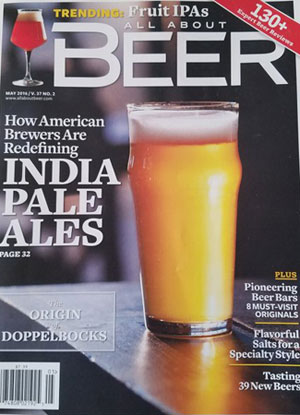MONDAY BEER LINKS, MUSING 6.27.16
Talking Pride Over Pints
Pride is an important part of what Robin LeBlanc says here, but so is this: “Longtime readers will no doubt agree with the fact that I see beer as exceptional background material to significant social goings-on. It’s the people you’re with that are more important than what you’re drinking, though it helps if the drink is good enough to help enhance the situation from behind the scenes. For the most part, beer should pleasantly accompany the night and not demand your attention if you don’t want it to.” [Via Torontoist, h/T Alan McLeod, among others]
Piero Rodriguez, MIA Beer brewer, killed in car crash.
It makes me sad I never heard of Rodriquez before he died. “And he was punk, through and through, from his tight pants with combat boots and T-shirts with obscure band names, to his taste in music. At MIA Beer, he set up a pair of turntables between the brewery and the tasting room, where he could watch over his gurgling beer boilers and spin everything from the Ramones to the Clash, not to mention a host of insider-only bands.” [Via Miami Herald]
Stout Decline: Guinness Slides in Popularity, Status.
So how are Guinness sales in the United States these days? I’ve recently wandered into several St. Louis taverns/pubs I don’t frequent, trying to settle on what to write about for The Session #113. I’ve seen lots of Guinness handles, and for that matter more drinkers choosing Guinness than, say, Ballast Point Sculpin. But I’ve also been in places that previously had Guinness on tap and it is no longer there. What does this all mean? [Via All About Beer]
What We Mean When We Talk About the ‘Death’ of Flagship Beers.
[Via This Is Why I’m Drunk}
Death of the Flagships: But Why?
[Via Stouts & Stilettos]
Is The Age of the Flagship Beer Over?
[Via Bear Flavored Ales]
And you thought “Brexit” was the story you couldn’t escape last week. This is an important business story if you are in the business. Thus ultimately it has implications for consumers. But as I just mentioned, I’ve recently been looking at draft selections at many taverns I don’t regularly frequent. This is obviously St. Louis specific, and to places where people gather just to talk, or sometimes because it is the best place to watch Jeopardy or the Cardinals or football/soccer or whatever on the TV. It is a small sample, and we’re not talking about what’s going on in grocery stores, convenient stores, and liquors store, where most beer is sold. I wouldn’t claim is represents the “other 99 percent” but it does fall outside the 1 percent that Bryan Roth (first link) writes about.
So what did I see? The Urban Chestnut tap handle is going to pour Zwickel, the Schlafly handle Pale Ale, the Civil Life handle American Brown, and so on. And there may well be buckets full of ice and Bud Light on the table. It’s not exactly the same everywhere. For one thing sometimes these breweries will have a second handle. And a can of 4 Hands City Wide sliding across a bar top is more noticeable than a bottle of Stag being jammed into a koozie. But there’s still a time and a place for the familiar.
Why you can’t get a pint in a beer bar anymore.
Another business/consumer story. If you make it to the end you’ll read Jeremy Danner talking about the Midwest, specifically Kansas City. It’s the same on the other side of Missouri, the neighborhood spots mentioned above almost always serving beer in pint glasses or “cheater” 14-ounce shakers — even beers you’ll get a smaller measure of if you visit the brewery. Jeff Alworth is also quoted at the end, but no mention of his honest pint project. [Via Washington Post]
How the sounds you hear affect the taste of your beer.
Didn’t Pete Brown already tell us this? [Via Washington Post]
11 jobs in the beer industry guaranteed to make you jealous.
Maybe not all 11. I don’t want to be the person “Upping America’s koozie game with one-size-fits-all beerwear.” However, given that Jared Williamson tweeted “Funny, production shift brewer isn’t on this list” a few examples why not: profiles of Jared, Jonathan Moxey at Perennail Arisan Ales, and Andrew Mason of 3 Floyds Brewing. Not the sexiest jobs going. [Via Trillist]
WINE & TERROIR (BECAUSE BEER TERROIR MAY ALSO BE A THING)
The Weird World Of Expensive Wine.
I’d be inclined to cross out the word “weird” and replace it with “terrifying.” “Maybe you can actually taste the money.” [Via FiveThirtyEight]
Demystifying Terroir: Maybe It’s The Microbes Making Magic In Your Wine
Wait, bacteria and fungi may affect the flavor? Have they heard about this in the Senne Valley? [Via NPR]
FROM TWITTER
As usual, click on the date to read the thread.
Have we created an untouchable top table of UK brewing? Beyond criticism.. All brand and bluster.. I'm beginning to think we have..
— Grandmaster Tash™ (@danielvane) June 19, 2016
 I should probably wait to comment on Jeff Alworth’s story until our postwoman delivers the latest All About Beer magazine (John Holl tweeted this
I should probably wait to comment on Jeff Alworth’s story until our postwoman delivers the latest All About Beer magazine (John Holl tweeted this